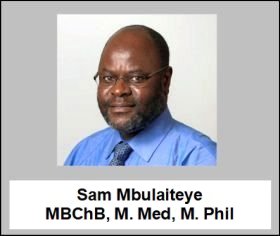
Sam Mbulaiteye, MBChB, M.Med M.Phil
___________
Senior Investigator, National Cancer Institute
Infections and Immunology Branch
Principal Investigator, EMBLEM
Earlier this year, I received the wonderful news of my selection for the prestigious Scientist of the Year
Award from the Lymphoma Foundation of America. I am humbled by this recognition and accept this
award with deep gratitude and respect for the patients with Burkitt lymphoma whose pain is
experienced at the periphery of medical systems, and the communities that support my research: the
Division of Cancer Epidemiology and Genetics (DCEG), National Cancer Institute,(NCI) and my
collaborators in Uganda, Kenya, and Tanzania.
My interest in Burkitt lymphoma began during my medical training in Uganda. Like most of my
colleagues, I had a rosy perspective on this unique disease and focused on intriguing facts: its
discovery in 1958 as a sarcoma of the jaw occurring in African (Ugandan) children; its contribution to
the discovery of Epstein-Barr virus (EBV), later linked to several other malignancies; its geographic
correlation with Plasmodium falciparum, a parasite that causes deadly malaria; its association with
chromosomal translocations, indicating a genetic "Achilles heel"; and is curability, in some instances
with monotherapy.
However, my experience as a physician revealed that our understanding of Burkitt lymphoma in Africa
was incomplete. I was increasingly distressed by its lethality in Africa; most children die from their
disease. We lacked knowledge as to why only some children develop Burkitt lymphoma, how to
advise affected communities on risk reduction, the potential benefit of increasing protection against
malaria, and whether specific EBV genetic variants that cause Burkitt lymphoma can be identified.
Some countries with malaria prevalence similar to parts of Africa, like some areas in India, do not have
a high burden of Burkitt lymphoma; could they be having a different EBV genetic variant? In short, I
concluded that neither epidemiological research nor clinical practice had progressed since its
discovery, leaving us with incomplete understanding of Burkitt lymphoma.
Over the past 10 years, I have had the opportunity to bring attention to Burkitt lymphoma through my
research at the NCI. My work has two primary aspects: to conduct research at multiple sites/countries
that are networked locally; and to strengthen causal inferences that can inform prevention, diagnosis,
and treatment. A networked approach is crucial because Burkitt lymphoma is rare. Enrollment at
multiple sites can increase the sample size and heterogeneity of exposures, which increases our
ability to draw meaningful conclusions with our research and allows sites to collaborate on common
problems. My major study is the Epidemiology of Burkitt Lymphoma in East African Children and
Minors (EMBLEM) Study (https://emblem.cancer.gov/), which brings together clinicians and
investigators from the USA, Uganda, Tanzania, and Kenya, and 18 institutions united in the goals of
strengthening the capacity to diagnose and treat Burkitt lymphoma and conducting collaborative
international research. Through EMBLEM we investigate:
- risk factors of endemic Burkitt lymphoma in populations in East Africa.
- immunological responses against EBV and P.falciparum or genetic variants of EBV and P.
falciparum that are associated with Burkitt lymphoma.
- molecular characteristics of tumors to better define Burkitt lymphoma subtypes; and
- genetic risk factors of Burkitt lymphoma using genome-wide association studies (GWAS) and
exome sequencing, and human leukocyte antigen (HLA) sequence-based typing or
imputation.
The first phase was completed successfully: a total 860 children with Burkitt lymphoma and 4000
healthy children (as a comparison group) were enrolled, and 50,000 vials of samples were
collected stored for future research. Thus far we have discovered that children who carry the sickle cell
trait genotype, which protects against severe malaria, have a lower risk for Burkitt lymphoma,
supporting a causal link between malaria and Burkitt lymphoma. Through the Burkitt Lymphoma
Genome Sequencing Project (BLGSP), EMBLEM data have contributed to better understanding of the
differences and similarities of EBV+ and EBV- Burkitt lymphoma. This work provides molecular
evidence that supports changing the current clinical practice of classifying Burkitt lymphoma cases
based on epidemiology (as endemic or sporadic) to Burkitt lymphoma classified based on EBV status
(as EBV+ or EBV- Burkitt lymphoma).
When I designed EMBLEM, I envisaged a scalable research infrastructure that could be leveraged to
address additional questions. This, indeed, is happening. Investigators at the University of Oxford
have partnered with investigators at some EMBLEM sites on the
Aggressive Infection Related East
African Lymphoma study to assess the accuracy of two low-cost novel diagnostic technologies (liquid
biopsy and mobile digital microscopy) as well as test the feasibility of using Rituximab to treat Burkitt
lymphoma in Africa.
Through EMBLEM I have focused on mentoring junior scientists as part of a long-term strategy to
sustain research on Burkitt lymphoma in response to local needs. I am pleased with the initial progress
in this regard as well: Dr. Samuel Kirimunda, a young investigator in Uganda, received a Beginning
Investigator Grant for Catalytic Research ($50K) from the African Organization for Research and
Training in Cancer (AORTIC) to conduct a
2-year project and a three-year Career Development
Fellowship from the European and Developing Countries Clinical Trials Partnership(€¬150K) to study
Burkitt lymphoma survival.
Burkitt lymphoma remains an important cancer affecting children in areas of East Africa with
significant P. falciparum infection. The success of EMBLEM confirms the feasibility of multidisciplinary
research on Burkitt lymphoma in East Africa and provides a basis from which future projects may
evolve. I am encouraged by exciting opportunities to diagnose Burkitt lymphoma more simply and
quickly, which will hopefully inform prevention and result in better treatment outcomes.
I am grateful for the recognition of this work by the Lymphoma Foundation of America. It shines a
bright light on the opportunities generated through our collaborations. I hope this recognition will
inspire more collaboration across the African continent and bring dividends of scientific discovery to
the children who suffer from Burkitt lymphoma.
|


